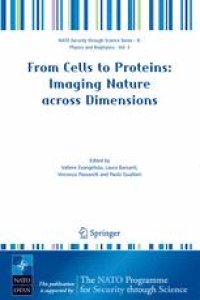
Ebook: From Cells to Proteins: Imaging Nature across Dimensions: Proceedings of the NATO Advanced Study Institute on From Cells to Proteins: Imaging Nature across Dimensions Pisa, Italy 12–23 September 2004
Author: John M. Girkin (auth.) Valtere Evangelista Laura Barsanti Vincenzo Passarelli Paolo Gualtieri (eds.)
- Tags: Life Sciences general, Cell Biology, Computer Appl. in Life Sciences, Biological Microscopy, Measurement Science Instrumentation
- Series: NATO Security through Science Series
- Year: 2005
- Publisher: Springer Netherlands
- Edition: 1
- Language: English
- pdf
How deep we can see inside Nature's smallest secrets? Will it be possible some day in the near future to investigate living structures at atomic level? This area of study is very interdisciplinary, since it applies the principles and the techniques of biology, physics, chemistry, mathematics, and engineering to elucidate the structures of biological macromolecules, of supramolecular structures, organelles, and cells. This book offers updated information on how much information we are able to obtain in the exploration of the inner details of biological specimens in their native structure and composition.
The book deals with the implementation of laser beam and stage scanning systems incorporating confocal optics or multiphoton microscopy; the advent of new electro-optical detectors with great sensitivity, linearity, and dynamic range; the possibility of 2D fast image enhancement, reconstruction, restoration, analysis and 3D display, and the application of luminescence techniques (FLIMT, FRET combined with the use of quantum dots), which gives the possibility to investigate the chemical and molecular spatio-temporal organization of life processes; Electron Microscopy and Scanning Force Microscopy (SFM), are also presented, which has opened completely new perspectives for analyzing the surface topography of biological matter in its aqueous environment at a resolution comparable to that achieved by EM.
How deep we can see inside Nature's smallest secrets? Will it be possible some day in the near future to investigate living structures at atomic level? This area of study is very interdisciplinary, since it applies the principles and the techniques of biology, physics, chemistry, mathematics, and engineering to elucidate the structures of biological macromolecules, of supramolecular structures, organelles, and cells. This book offers updated information on how much information we are able to obtain in the exploration of the inner details of biological specimens in their native structure and composition.
The book deals with the implementation of laser beam and stage scanning systems incorporating confocal optics or multiphoton microscopy; the advent of new electro-optical detectors with great sensitivity, linearity, and dynamic range; the possibility of 2D fast image enhancement, reconstruction, restoration, analysis and 3D display, and the application of luminescence techniques (FLIMT, FRET combined with the use of quantum dots), which gives the possibility to investigate the chemical and molecular spatio-temporal organization of life processes; Electron Microscopy and Scanning Force Microscopy (SFM), are also presented, which has opened completely new perspectives for analyzing the surface topography of biological matter in its aqueous environment at a resolution comparable to that achieved by EM.
How deep we can see inside Nature's smallest secrets? Will it be possible some day in the near future to investigate living structures at atomic level? This area of study is very interdisciplinary, since it applies the principles and the techniques of biology, physics, chemistry, mathematics, and engineering to elucidate the structures of biological macromolecules, of supramolecular structures, organelles, and cells. This book offers updated information on how much information we are able to obtain in the exploration of the inner details of biological specimens in their native structure and composition.
The book deals with the implementation of laser beam and stage scanning systems incorporating confocal optics or multiphoton microscopy; the advent of new electro-optical detectors with great sensitivity, linearity, and dynamic range; the possibility of 2D fast image enhancement, reconstruction, restoration, analysis and 3D display, and the application of luminescence techniques (FLIMT, FRET combined with the use of quantum dots), which gives the possibility to investigate the chemical and molecular spatio-temporal organization of life processes; Electron Microscopy and Scanning Force Microscopy (SFM), are also presented, which has opened completely new perspectives for analyzing the surface topography of biological matter in its aqueous environment at a resolution comparable to that achieved by EM.
Content:
Front Matter....Pages i-xii
Optical Microscopy for Cell Imaging....Pages 1-22
Introduction to Transmission and Scanning Electron Microscopy....Pages 23-35
Potential and Limitation of Cytochemistry....Pages 37-52
Cryotechniques for Electron Microscopy: A Minireview....Pages 53-70
Cell Membrane Specializations as Revealed by the Freeze-Fracture Technique....Pages 71-84
Imaging, Measuring and Manipulating Biological Matter from the Millimeter to Nanometer Scale....Pages 85-110
Inside the Small Length and Energy Scales of the World of the Individual Biological Molecule....Pages 111-137
Scanning Probe Microscopy across Dimensions....Pages 139-165
Imaging Cells Using Soft X-Rays....Pages 167-185
From Microscopy to Nanoscopy: How to Get and Read Optical Data at Single Molecule Level Using Confocal and Two-Photon Excitation Microscopy....Pages 187-207
Fluorescence Resonance Energy Transfer (FRET) and Fluorescence Lifetime Imaging Microscopy (FLIM)....Pages 209-216
Quantum Dots, a New Tool for Real-Time in Vivo Imaging....Pages 217-225
Image Acquisition and its Automation in Fluorescence Microscopy....Pages 227-270
Stereological and Digital Methods for Estimating Geometrical Characteristics of Biological Structures Using Confocal Microscopy....Pages 271-321
Wavelength as the Fourth Dimension in Light Microscopy....Pages 323-333
Time as the Fifth Dimension in Microscopy....Pages 335-348
Image Deconvolution....Pages 349-370
Image Formation in Fluorescence Microscopy....Pages 371-393
Atomic Force Microscopy Study of Pili in the Cyanobacterium Synechocystis SP. PCC 6803....Pages 395-403
Changes of Algae Protein Complex under pH Effect....Pages 405-414
Leaf Fluorescence as Diagnostic Tool for Monitoring Vegetation....Pages 415-421
Dynamic Holography for Study of Nonlinear Optical Processes in Biological Photoreceptor Molecule....Pages 423-430
“Seeing” Lipid Membranes by Solid-State NMR....Pages 431-450
Visuomotor Coordination in Behaviour of Pigeons Following Post-Hatching Monocular Experience: An Image Analysis Study....Pages 451-458
Back Matter....Pages 459-469
....Pages 471-479